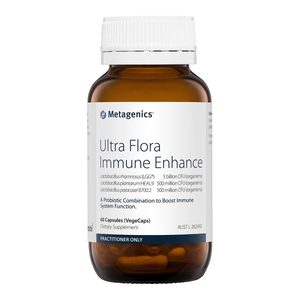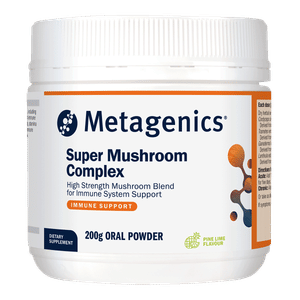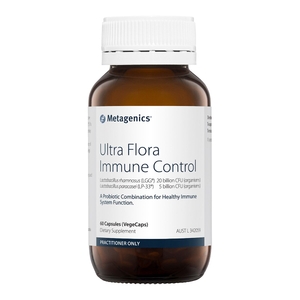
Maintaining a robust immune system is a fine-tuned process, striking a balance between stimulatory and regulatory immune functions; defending against infection, responding to tissue injury and repair, and regulating cellular changes that can lead to disease. Environmental factors, including poor gut health, nutritional deficiencies, sleep dysregulation, and stress may disrupt this balance, causing a reduced or dysfunctional immune response.
In susceptible individuals, these factors drive pathological processes that exhaust the immune response (increasing susceptibility to an acute infectious onset and paving the way for recurrent and chronic infection), increase immune reactivity (creating allergens from otherwise innocuous substances), or deteriorate immune tolerance and inflammatory control mechanisms (leading to autoreactivity and inflammation). The complexity of immune presentations therefore requires evidence-based solutions that target insufficient immune stimulation (associated with infection), as well as aberrant immune overactivity (associated with allergy and autoimmunity).
Bringing Immune Balance to Your Patients
Fortunately, Metagenics provide tailored immune solutions (Figure 1), enabling symptomatic relief while also building immune resilience. This approach utilises a suite of herbal and nutritional interventions that provide immune stimulation for acute, recurrent and chronic infections, as well as anti-inflammatory support and immune regulation for allergic and autoimmune conditions. Key nutrients, which are foundational to immune balance, are also available to prevent an infectious onset and restore balance to a dysfunctional immune response.
Figure 1. Condition-specific solutions that enhance immunity and prevent immune dysfunction

When Pathogens Attack
For patients susceptible to infection, strain-specific probiotics with proven human health benefits, such as those in Lactobacillus plantarum HEAL9, Lactobacillus paracasei 8700:2 and Lactobacillus rhamnosus (LGG®) to Boost Immunity, are uniquely positioned to enhance the immune response.
Illustrating this, a clinical trial involving 898 participants who were administered 500 million colony-forming units (CFU)/d each of HEAL 9 and 8700:2 for 12 weeks revealed a 30% reduction in the incidence of recurring colds and an 18% decline in analgesic use compared to placebo (1). Additionally, a meta-analysis consisting of 1,805 children aged 0 to 18 years demonstrated that Lactobacillus rhamnosus (LGG®) significantly reduced acute otitis media episodes, upper respiratory tract infections and antibiotic treatments, while also decreasing overall respiratory infections in children older than 1 year (2).
Amplifying Immunity During Acute Infections
Combining immune-stimulating probiotics with herbs that have been demonstrated to boost immune function may alleviate acute infections such as cold and flu. For instance, a meta-analysis of 33 randomised controlled trials consisting of 7,175 patients revealed andrographis, (supplemented in doses ranging between 15.75 mg/d to 1,200 mg/d) significantly reduced cold and influenza symptoms and shortened illness by one to three days (3). Recent research has shown epigallocatechin-gallate (EGCG) from Camellia sinensis (green tea) forms ionophores with zinc to increase intracellular zinc concentrations (4) and inhibit replication of ribonucleic acid (RNA) viruses including rhinoviruses, influenza and coronaviruses (5). Additionally, ingredients such as vitamins C (6) and D (7) may also help to modulate immune function, regulate inflammatory cytokine activity and reduce viral load, minimising the severity of acute respiratory tract infections. The combination of these ingredients, found in NK Cell Regulation, are therefore indicated for patients that require acute infectious management.
Mushrooms for Managing Recurrent Infections
For recurrent infections, ingredients within Cordyceps, Coriolus and Reishi for Immune Stimulation have been found to increase resistance to infectious illness (8,9,10,11). Specifically, the β-glucan structure present within mushroom polysaccharides stimulate T cell immunity, supporting adaptive immunity when fighting infection (12).
Highlighting these benefits, a study involving participants with positive antibody titres for Epstein-Barr virus demonstrated a 77% increase in T cell activation and a 35% increase in natural killer (NK) cell activity when administered 3 g/d of coriolus for two months (Figure 2) (13). Additionally, 350 mg/d of reishi beta-glucans ingested for five days per week over 12 weeks was found to increase cluster of differentiation 4 (CD4+) and CD8+ T cell lymphocytes (14). As such, Cordyceps, Coriolus and Reishi for Immune Stimulation is an appropriate consideration to mitigate recurrent infections.
Figure 2. Increased T cell activation and NK cell activity associated with coriolus supplementation (13)

Additionally, Mushrooms and Astragalus for Immune System Support combines coriolus and reishi with herb, Astragalus membranaceous (astragalus), for patients requiring immune support and fatigue management (15). Astragalus has been demonstrated to modulate the inflammatory response, while also increasing leukocyte populations, antigen presentation and complement protein synthesis (15). Known as a ‘Qi-tonifying’ herb, astragalus has a long history of use in Traditional Chinese Medicine for reducing fatigue and improving vitality in patients with a debilitating illness (16,17) providing an alternative for individuals experiencing fatigue associated with recurrent infection.
Active Hexose Correlated Compound (AHCC™) to Resolve Chronic Infections
For chronic or serious infection, where the immune system is unable to eradicate the pathogen, a propriety enzyme-fermented extract of shiitake, known as AHCC™, has been found to stimulate innate and adaptive immune responses. These actions include boosting cytokine production, enhancing NK cell function, promoting macrophage activity, and increasing dendritic cell numbers (18,19,20,21).
A testament to these benefits, AHCC™ has been used clinically in more than 600 international hospitals (22,23) and had been shown to heighten immune response in over 20 human clinical trials (19).
Recently, supplementation with AHCC™ at 3 g/d for three to six months increased the clearance of chronic cervical human papillomavirus infection in 66% of participants (24). Additionally, AHCC™ provided to cancer patients receiving chemotherapy inhibited human herpes virus-6 reactivation (25). Therefore, AHCC™ and Ginger is suitable for immunosuppressed individuals, particularly those with chronic infections.
Regulating Overactive Immunity
Patients presenting with immune hypersensitiveness, such as allergies, atopic conditions, and autoimmunity, may benefit from Lactobacillus paracasei LP-33® and Lactobacillus rhamnosus LGG® for Immune Control. These immune-modulating, anti-inflammatory probiotic strains promote immune regulation by interacting with dendritic cells within the gut-associated lymphoid tissue, stimulating the production of regulatory T cells and regulatory cytokines, such as interleukin-10 (IL-10) and transforming growth-factor beta (TGF-β) (26). Demonstrating LP-33™’s effectiveness, subjects with allergic rhinitis experienced significant improvements in their Rhinitis Quality Of Life (RQLQ) score, nasal and ocular symptoms after five weeks of supplementation (27). Further, LGG® has been shown to significantly reduce rheumatoid arthritis (RA) inflammation (28), decrease Crohn’s disease activity (29) and help maintain clinical remission alongside mesalazine in ulcerative colitis patients (30).
Dialling Down the Allergic Response
For patients presenting with food and environmental allergies, treatment alternatives that support immune regulation and promote immune tolerance to allergens can allow patients to live more expansive lives. For instance, reishi has been found to restore the T helper 1 (Th1)/Th2 imbalance and histamine-induced immune response associated with allergy (31,32). Further, perilla’s anti-allergic activities have been highlighted in several clinical trials, demonstrating reduced Th2 cytokine production, inhibition of nuclear factor kappa B (NFƙB) and subsequent cytokine synthesis, as well as minimising tumour necrosis factor-alpha (TNF-α), immunoglobulin E (IgE) antibodies and histamine release (33).
Comprised of these ingredients, Chinese Mushrooms, Skullcap and Perilla for Allergy Tolerance helps to moderate the underlying factors that perpetuate allergy (Figure 3). These include promoting Th cell regulation, modulating gastrointestinal and systemic immunity, regulating inflammation, and supporting liver clearance of immune complexes, which collectively enhance allergen tolerance and reduce allergic reactions.
Figure 3. Key ingredients to build tolerance

While the treatment of allergic drivers is underway, Quercetin, Bromelain and Aller-7® for Allergy Symptom Relief can alleviate symptomatic discomfort by minimising the local and systemic inflammation associated with allergy. Clinically trialled Aller-7® (tested in over 500 patients) (34,35) along with quercetin and bromelains, can reduce allergic reactions through potent inhibition of histamine release and reduction of oedema and inflammatory processes (36,37,38,39,40). As such, this combination provides relief of symptoms in those suffering from a variety of allergies and sensitivities including respiratory, skin and food reactions.
Attenuating Autoimmune Inflammation and Encouraging Resolution
For patients presenting with autoimmunity or conditions involving increased inflammatory load, formulas that attenuate inflammation, mitigate tissue damage and promote resolution can help to repair damage to afflicted tissues and reduce disease activity. Specifically, BCM-95™ Turmeric and Devil’s Claw to Treat Chronic Inflammation contains several herbs that reduce the production of inflammatory mediators.
BCM-95™ Turmeric has been shown to inhibit the activity of the inflammatory gene, cyclooxygenase–2 (41), as well as a plethora of other pro-inflammatory compounds (42). Additionally, both BCM-95™ Turmeric and BosPure® Boswellia have been found to prevent the activation of NFƙB, therefore inhibiting signalling pathways involved in down-stream inflammatory cytokine production (43,44). For added benefit, devil’s claw provides analgesic effects by simultaneously increasing gamma-aminobutyric acid (GABA) activity and reducing glutamate signalling (45), while Jamaica dogwood has been shown to inhibit inflammatory enzymes associated with pain (46). In doing so, these herbs may reduce pain sensations associated with chronic inflammation.
In instances of chronic, unresolved inflammation, where resolution rather than inhibition of inflammatory mediators is required, Specialised Pro-Resolving Mediators (SPMs) are recommended, particularly in patients with chronic inflammation or when medical conditions are exacerbated by inflammation. SPMs are lipid mediators that activate the resolution phase at the site of inflammation by regulating macrophage polarisation (switching from the M1 to the M2 phenotype), while also repairing tissue damage, enhancing pathogen clearance and preventing further pathological inflammation without immunosuppression (47,48).
Prevention is Always Better Than Cure
Foundational nutritional therapy using key ingredients such as zinc, vitamin C and vitamin D provides the key building blocks for immune health, paramount to maintaining a resilient immune response.
Zinc is integral to intracellular signalling pathways for both innate and adaptive immunity (49), along with the development of non-specific immunity, including neutrophils and NK cells, and acquired immunity (50). Research has found low zinc status correlates with increased susceptibility to infections, including diarrheal diseases or viral infections, as well as reduced T and B lymphocyte function, and decreased thymic hormone production (which regulates the development of immune-competent cells) (51).
Zinc combined with vitamin C has been found to alleviate common cold symptoms more effectively than placebo (52); a finding likely owing to vitamin C’s capacity to boost lymphocyte differentiation and proliferation, antibody synthesis and white blood cell production and function (53). As such, High Bioavailability Zinc with Vitamin C or High Bioavailability Zinc with P5P, are appropriate considerations for nourishing immune health.
Vitamin D also regulates immune function, with deficiency impacting the activity of T regulatory cells (54,55), as well as the production of antibodies and dendritic cell function (56). Further, vitamin D has been found to enhance the differentiation of monocytes to macrophages and stimulate white blood cell proliferation, essential to neutralising viral infections (57); placing vitamin D in good stead to boost immunity.
Immune Solutions Your Patients Will Love
Given the broad spectrum of immune presentations that can range anywhere from insufficient immune stimulation to heightened immune overactivity, a one-size-fits-all approach is far from ideal when treating immunological conditions. As such, evidence-based strategies to either regulate or stimulate the immune system, combined with preventative nutrition, allows Practitioners to prescribe customisable solutions with confidence, providing symptomatic relief while building a robust immune system that benefits your patients.








